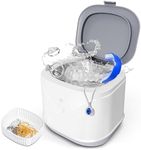Buying Guide for the Best Ultrasonic Retainer Cleaners
Ultrasonic retainer cleaners are devices designed to clean dental retainers using ultrasonic waves. These waves create high-frequency vibrations that help to remove debris, bacteria, and plaque from the retainer surfaces. When choosing an ultrasonic retainer cleaner, it's important to consider several key specifications to ensure you select a model that effectively meets your cleaning needs and fits your lifestyle.Ultrasonic FrequencyUltrasonic frequency refers to the number of vibrations per second produced by the cleaner, measured in kilohertz (kHz). This is important because higher frequencies can provide more thorough cleaning by creating smaller bubbles that can reach into tiny crevices. Frequencies typically range from 20 kHz to 45 kHz. Lower frequencies (20-30 kHz) are suitable for general cleaning, while higher frequencies (35-45 kHz) are better for delicate or intricate items. If your retainer has complex features or is particularly dirty, a higher frequency might be more effective.
Tank CapacityTank capacity refers to the volume of the cleaning chamber where the retainer is placed, usually measured in milliliters (ml). This is important because it determines how much cleaning solution you can use and whether the retainer fits comfortably. Smaller tanks (100-200 ml) are suitable for single retainers, while larger tanks (300 ml and above) can accommodate multiple items or larger dental appliances. Consider the size of your retainer and whether you plan to clean other items simultaneously when choosing the tank capacity.
Cleaning TimeCleaning time is the duration of a cleaning cycle, typically ranging from 3 to 10 minutes. This is important because it affects how quickly you can clean your retainer. Shorter cycles (3-5 minutes) are convenient for quick cleans, while longer cycles (6-10 minutes) may be necessary for more thorough cleaning or heavily soiled retainers. If you need a quick daily clean, opt for a model with shorter cycles, but if you often deal with stubborn stains, a longer cycle might be beneficial.
Noise LevelNoise level refers to how loud the cleaner is during operation, usually measured in decibels (dB). This is important if you are sensitive to noise or plan to use the cleaner in a shared or quiet environment. Lower noise levels (below 50 dB) are considered quiet and less likely to disturb others, while higher levels (above 60 dB) might be noticeable. If you prefer a quieter operation, look for models specifically designed to minimize noise.
Additional FeaturesAdditional features can include things like digital timers, automatic shut-off, and multiple cleaning modes. These features are important as they can enhance the usability and effectiveness of the cleaner. A digital timer allows you to set precise cleaning durations, while an automatic shut-off ensures the device turns off after the cycle, saving energy and preventing overuse. Multiple cleaning modes can offer different intensities or cycles for various cleaning needs. Consider which features align with your preferences and cleaning habits.







